Kruger National Park Safari Information Guide
Our Kruger National Park Safari Information Guide tells you what you need to know so that your Kruger Park safari is everything you hope it will be.
Please take the time to read through it carefully as it covers important information on:
- Transport to and from Kruger National Park
- Your daily itinerary
- Game viewing expectations
- What to take on your game drives
- What to pack for your trip
- Tipping in South Africa
- Safety in South Africa
- Malaria
- Optional extra activities
- The seasons and weather
Our Kruger National Park Safari Information Guide can also be downloaded.
1. Transport to and from Kruger National Park
Depending on logistics, you'll be collected from the airport or nearby hotel by a Wild Wings Safaris guide and vehicle, a third party transport company or a shuttle service. This means you'll be chauffeured by a professional driver to the Kruger in a properly licensed and insured air-conditioned vehicle.
If you're collected by a third party shuttle service, you'll be met by your Wild Wings Safaris guide when you enter the Kruger National Park. There, you'll transfer to an open safari vehicle and immediately start your first game drive en route to your camp.
The trip from Johannesburg to Kruger normally takes about 6 hours. Along the way, we make one or two comfort stops. If you need to stop, please ask the driver. Have some cash ready to buy your own snacks or lunch en route as the first included meal is dinner in the evening. Drinks are excluded but you can buy some at one of the comfort stops or at the Kruger supermarket at camp.
If you transfer to the Kruger with a third party transport company, the driver might not remind you to buy lunch. Please ask at the first comfort stop for the best place to buy lunch. If you're flying to Nelspruit (KMIA), please buy something to eat when you land. After we pick you up, there are no stops between Nelspruit and Kruger.
Look at your Booking Confirmation Document to find your exact pickup details and time. If for logistical reasons, these details change, we'll always send you an updated version. Please be ready on time so we don't inconvenience other guests. Also, if your pickup is late, don't panic. It could be due to unforeseen traffic delays.
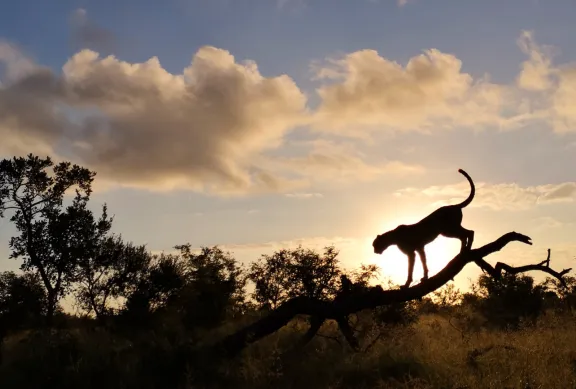
Kruger cheetah
Safari Information Guide Kruger National Park Wild Wings Safaris
Download the "Transport to and from Kruger National Park" PDF above.
2. Your daily itinerary
Our Kruger Park safari itineraries are flexible and devoted to open safari vehicle game viewing. We wake you up in the early morning with a knock on your door and try to head out on our first game drive before sunrise. This is when game viewing is best. Nocturnal animals can sometimes still be seen. Before departure or during the early part of the game drive, your guide will find a suitable spot for early morning coffee or tea and rusks (a traditional, twice-baked cookie). We then continue our search for animals as the day starts to warm up with the rising sun.
Around mid-morning, we enjoy an extensive breakfast/brunch at a picnic site along the way or back at camp after the game drive. Sometimes on cold winter mornings when the sun rises later, breakfast might be served before departing on a longer game drive. Your safari guide will always keep you informed of the schedule for the day. Breakfast is either prepared by your Wild Wings Safaris guide, or our catering partners will set up breakfast in camp while you're out enjoying your morning game drive.
After breakfast, if the guide hears reports of interesting sightings in the area, they'll discuss with you the option of following those up and continuing the game drive or staying at camp for a relaxed afternoon. Lunch isn't included because of the extensive mid-morning breakfast but you can always buy something light from the camp take-away cafeteria or snacks from the supermarket. While you're there, don't forget to buy your own drinks or wine for dinner.
Our second game drive is in the afternoon when the sun is lower. This is another great time for game viewing as the animals become more active when temperatures drop. We may stop for a leg stretch but will return to camp by sunset. There will be time to freshen up before dinner which is served in the camp restaurant or alfresco, weather permitting. We normally try to include a traditional South African "braai" or barbecue and there's no need to dress up for dinner.
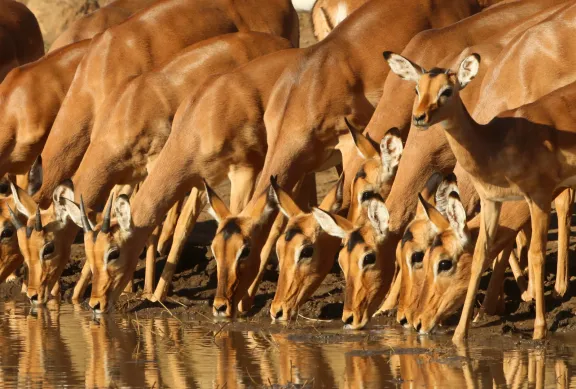
Kruger impala
Download the "Your daily itinerary" PDF above.
3. Game viewing expectations
Every game drive is unique and there's no guarantee you'll see all the animals on your bucket list. Please don't have too many expectations and enjoy the sightings you do have. The animals you're likely to see include elephant, buffalo, giraffe, zebra, wildebeest (gnu), white rhino, various antelope species, baboons, monkeys and hippo.
With some luck, you might see predators like lion, leopard, hyena, cheetah and perhaps African wild dog. It's unlikely you'll see all the predators on one trip (cheetah and wild dog are very rare). The greater Kruger National Park is over 2.2 million hectares in size and the animals roam around freely. Keep in mind that on some days, certain sightings are better than others.
In Kruger Park, vehicles aren't allowed to leave the road so some sightings may be further away than others. A bit of luck is involved, especially when it comes to predators. Our records show that we've sighted lions at least once on 9 out of every 10 safaris and leopards at least once on 70% of our safaris (leopards are very shy and often difficult to find). On some safaris, we were unlucky and saw no big cats but other interesting sightings made up for it. Part of the excitement is not knowing what you'll see and what you might find around the next corner!
Don't be shy to ask the guide questions or to repeat themselves if you didn't hear or understand properly – this won't offend them. Also, tell the guide if you can't see the sighting properly and want the vehicle moved to another position. Most guides have a variety of field guides and identification books or apps, and they'll be happy to share them with you if you wish to identify a bird or animal. Binoculars are a must-have on game drives. We provide a few pairs for guests who didn't bring any but it's always preferable to have your own.
During game drives, you must stay seated. Standing up or leaning out of the vehicle is a safety risk and might scare the animals away. Don't interfere with the wildlife in any way. Please don't feed them, throw things at them or scare them with loud noises. It's common courtesy to lower your voice at sightings and to keep your movements to a minimum so as not to scare the animals off. Keep your arms and legs inside the vehicle.
Never try to touch wild animals, even inside the camp when you think the antelopes, warthogs or monkeys that sometimes cross your path look "tame". Keep food out of sight because some monkeys have lost their fear of humans and have learned to grab food from people. All animals can bite so keep your distance.
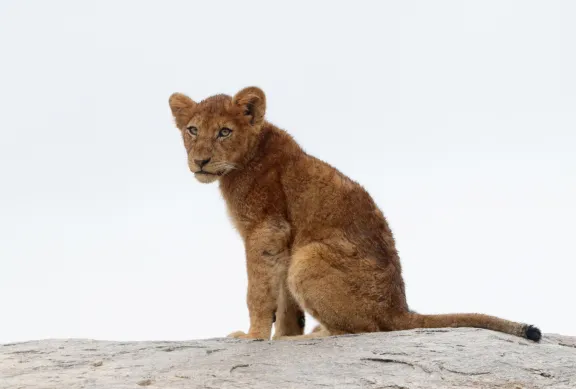
Kruger lion cub
Download the "Game viewing expectations" PDF above.
4. What to take on your game drives
Take care not to lose anything during the game drive. It can get windy on the back of the safari vehicle; hats or caps tend to blow off. It's also easy for phones to slip out of pockets on bumpy stretches of road, so please check you have everything on you before you disembark from the safari vehicle after a game drive.
We recommend that you take the following items with you on your game drives:
- Your camera
- Binoculars
- Warm clothes
- A bottle of water
- A cap or sunhat
- Sunglasses
- A flashlight
- Some snacks to nibble on
- Your valuables (wallet, phone, credit cards, passports, etc.)
- A small bag to carry everything in
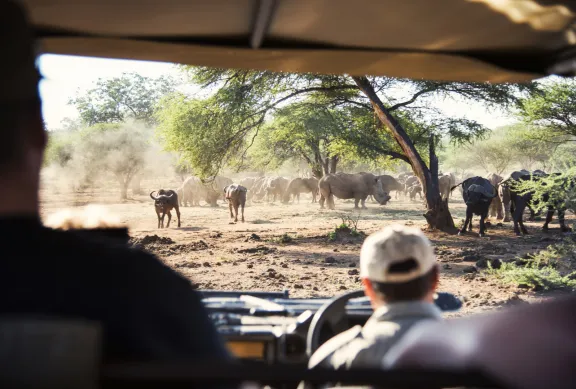
A herd of buffalo and white rhino seen from a game drive vehicle
Download the "What to take on game drives" PDF above.
5. What to pack for your trip
Bring comfortable shoes or sandals, cool clothing for the day, long pants and a warm jacket for the evenings and early mornings. In winter from April to September, it gets very cold on early morning game drives. Pack a warm windbreaker, beanie or ear-warmers and gloves. In winter, we provide courtesy blankets on game drives and a light raincoat or poncho may come in handy if you're coming on safari during the rainy season from November to March.
Dress in layers so you can shed them as the day warms up. A small carry bag is useful to keep your things on you during game drives. It comes in handy on those bumpy dirt roads. Binoculars are important. A pair of 8x40 or 10x42 is a good option.
Most camps have a swimming pool so bring your swimsuit (optional), hat, sunglasses, sunscreen lotion, camera, flashlight, spending money for drinks and personal expenses, insect repellent, anti-malaria medication and other prescription medication you may need
You'll also need to bring your own toiletries including shampoo, conditioner, shower gel or soap. On flights, liquids aren't permitted in hand luggage so you'll need to store them in your checked luggage. Squeeze out some air from your bottles before placing them in a closed plastic bag or Ziploc bag to prevent spilling. Towels are provided but consider bringing your own small hand towel and pool towel.
Bring a 220V international travel adapter with prongs suitable for the local wall plugs. In South Africa, only type M (3 prongs) and type C (2 prongs) are used. In Botswana, Zimbabwe, Zambia and Tanzania, the UK version type G (3 prongs) is also commonly used. Click here for details.
Don't forget your travel documents, insurance papers, valid passport with at least two blank pages and expiry date more than 6 months away and your flight tickets. If you're travelling with children under 18, click here for details.
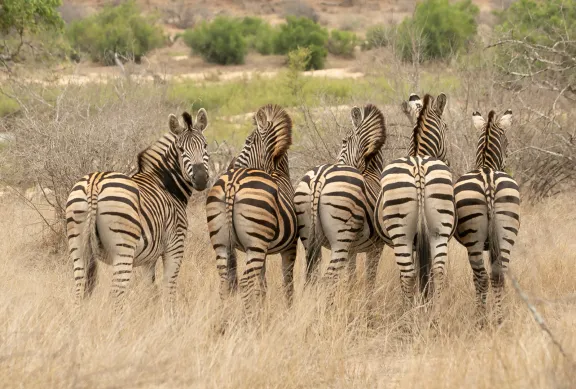
Kruger zebra
Download the "What to pack for your trip" PDF above.
6. Tipping in South Africa
It's customary to leave a tip at the end of your safari. Safari guides usually earn little and tips are always appreciated. It might come across as insulting to leave no tip, a very small tip or a memento from your home country instead of a tip – most guides already have a large collection of novelty items given to them by well-meaning guests. A cash tip in the local currency of South African Rands is always better.
We believe tipping should be at the guest's discretion and should reflect the quality of service received. If you were very satisfied, leave a generous tip. If you received poor service, leave a smaller tip. To leave no tip at all is frowned upon. We hesitate to suggest an amount but it's customary to tip a safari guide about R120 to R150 ($10 to $12) per person per day. So for a 3-day safari, for example, a couple might tip anything between $60 and $80. A more generous tip would reflect that you were very happy with the safari and the service from the guide. While leaving no tip might be common for certain nationalities, this would communicate to the guide that you weren't satisfied with the safari at all.
If you'd like to tip the cleaning staff, you can leave a tip in the room on the day of your departure, preferably in local currency (South African Rand). R20 to R50 per day is seen as reasonable. It is also customary to tip porters and transfers drivers R10 or R20. Industry wages are low, so the tips are really appreciated. At restaurants, leaving at least a 10% tip is customary and most establishments don't automatically add a service charge to the bill.
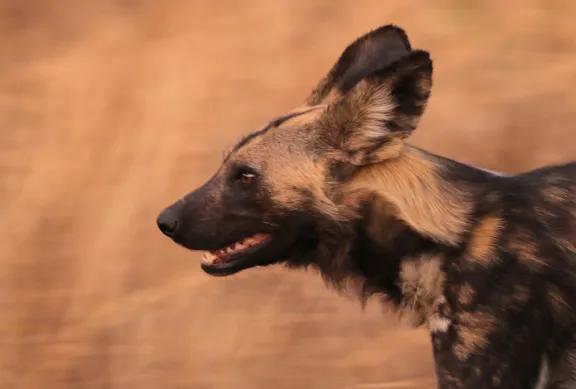
African wild dog on the move
Download the "Tipping in South Africa" PDF above.
7. Safety in South Africa
Guest safety is our number one priority. South African safari guides are highly trained. If you follow their instructions during game drives or bush walks, you won't be in any danger from animals. If you get very close to elephants, for example, you'll be asked to sit still and keep quiet. Sudden movements or noises might scare the animal or provoke it. Attacks on humans or vehicles are very rare so you don't have to worry. All animals are scared of humans, especially groups of humans.
Kruger Park camps are securely fenced so it's safe to walk around at night. Don't walk barefoot in the dark, though, as there may be scorpions. Always use a flashlight. Closed shoes are best but sandals are fine with your flashlight to light the way. Shake out your shoes in the morning before putting them on.
Never feed any animals or even birds. This carries a hefty fine. Monkeys and baboons can be a nuisance. If they've been fed by humans, they get bold and will grab food right off your breakfast table or out of your hand. Sometimes, they break into tents or bungalows in search of food so don't leave food about in your room. Close and lock all windows and doors before you go out. You'll be surprised what havoc monkeys can wreak if they manage to get into your room! All animals can bite so never attempt to stroke or touch an animal, no matter how tame or cute the animal appears.
Crime is a concern for many visitors to South Africa but this isn't something you need to worry about. O.R. Tambo International Airport, Kruger National Park and other destinations along the way are very safe areas and we've never had an incident of crime on our safaris (except for a few cases of petty theft from a bungalow or hotel room). It's best not to leave any valuables or money lying around in your bungalow as cleaning staff have access to your room. Don't leave your phone, tablet or other valuable electronic devices in your room to charge while you're out on game drives. Always keep your cash, credit cards and passports with you.
That said, game drives can be bumpy so don't put valuables into a shallow pocket where they can fall out during the game drive. The same applies to your rental car if you have one – don't leave valuables like cameras, tablets or wallets in a parked car. Also, don't pack any valuables in your check-in luggage during a flight. Keep all valuables including your cash, credit cards, passports, camera, tablet and jewellery with you or in your hand luggage.
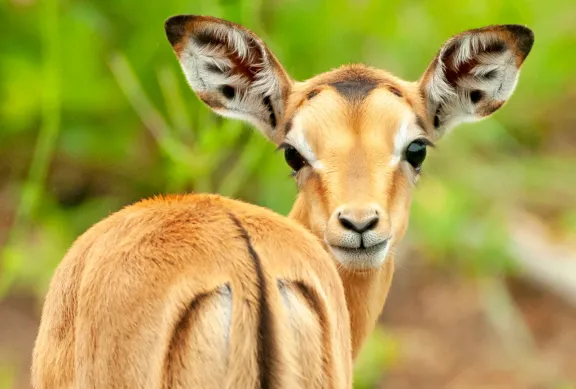
Impala lamb
Download the "Safety in South Africa" PDF above.
8. Malaria
The greater Kruger National Park is a low-risk malaria area in winter and a medium risk area in summer between September and April.
The best way to prevent malaria is to avoid mosquito bites by wearing light, long-sleeved clothing that covers the skin. Apply mosquito repellent to exposed skin like ankles and feet. At night, keep your windows and doors closed, unless there are mosquito screens. Sleep under a mosquito net and keep the overhead fan and/or air-conditioning running. Fortunately, malaria is very rare among visitors to Kruger. To our knowledge, not one of our guests has ever contracted malaria.
Consult your doctor or travel clinic about anti-malaria drugs, particularly if you're pregnant or taking other medication. Click here for further details.
SANParks recommends anti-malaria drugs from September to April. Between May and August, they're considered optional. If you get bitten, don't panic. Only 1 in 10,000 mosquitoes carry malaria. If you develop flu-like symptoms during or after your safari, consult your doctor immediately. Tell them you've been to a malaria area and ask to be tested for malaria.
Keep in mind that taking anti-malaria medication can mask the symptoms of malaria and make it harder to detect. If the test is negative but you feel worse the next day, get your doctor to repeat the test. Don't panic. Malaria can be treated.
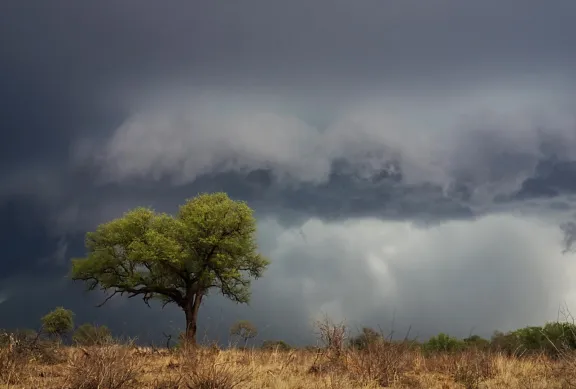
Kruger thunderstorm
Download the "Malaria" PDF above.
9. Optional extras
In Kruger National Park, if your safari is 3 days or longer, it may be possible to do a bushwalk or night drive as an optional extra. These are conducted exclusively by Kruger Park rangers. You can book this through your guide who'll, subject to availability, make the necessary arrangements. Better still, book this in advance with your consultant to ensure a place.
Please note: If you do a bushwalk, you'll miss a morning game drive. If you do a night drive, you'll normally miss an afternoon game drive.
Mostly, night drives depart before sunset at around 17h00 and return about 20h00. Some camps offer late-night drives departing around 20h00 and returning late into the night.
A quick disclaimer: We have no control whatsoever over the vehicle and guides used by SANParks for these optional extra activities. In our experience and based on guest feedback, the quality varies greatly. Some SANParks guides are terrific, others are really terrible.
If you've booked a safari that includes a bushwalk or night drive like our 5-Day Best of Kruger Safari, please be aware that the bushwalk in particular is subject to availability and dependent on suitable weather conditions. If it's raining or there's a strong wind, the bushwalk can be cancelled at the discretion of the ranger without prior notice. No refund is due. We will, however, take you on a game drive in place of the bushwalk.
A bushwalk is not so much about game viewing because, as a rule, animals tend to run away from humans on foot. It's more about experiencing the African bush on foot and enjoying the smaller wonders of the wild that you'll miss out on while driving. This includes things such as animal tracks and droppings, plants and their various uses, and the sheer joy of listening to the sounds of the bush undisturbed by the sound of a safari vehicle.
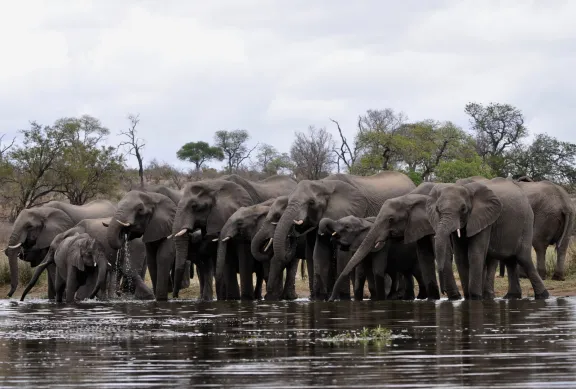
Elephants gathering to drink
Download the "Optional extras" PDF above.
10 Seasons and weather
Overall, South Africa's Kruger National Park is a popular destination all year round and each season has its advantages. It's hottest from October to March and on some days the temperature can exceed 40°C (or 104°F).
The rainy season is from November to March. It's hot and humid during this time. There are more insects but also more flowers, more birds and more baby animals. The bush is lush and green.
The dry winter season runs from May to September. Expect cold nights but pleasant, sunny days.
As the dry season progresses, the bush becomes dry and dusty. It may not look as pretty but it's more open and animals tend to congregate near waterholes which makes game viewing easier.
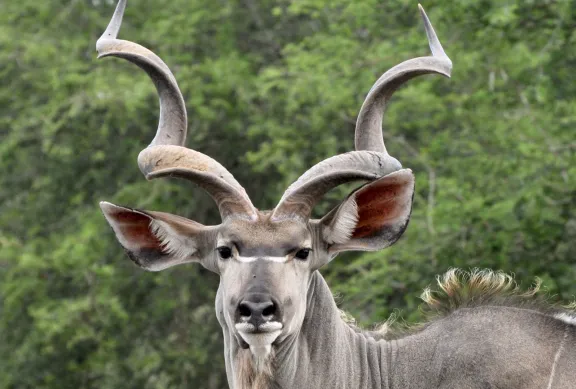
Kruger kudu
Download the "Seasons and weather" PDF above.




